Every now and then my local library has a book sale and some years ago, whilst eagerly scanning the book titles, one of Virago’s familiar dark green covers caught my eye. It was High Albania by a woman I’d never heard of, Edith Durham, (1863-1944). First published in 1907, it was an eye-witness account of her hair-raising travels in the mountains of Albania. Intrigued, I bought it.
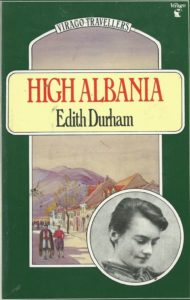
High Albania by Edith Durham
Albania was then part of the dying Ottoman Empire and the mountains of northern Albania were occupied by fiercely independent tribes, who stuck to their age-old customs, including notorious blood feuds which, it was calculated, killed up to 19% of the men. The female death rate and infant mortality was almost equally high, due to the appalling lack of hygiene, especially during childbirth and infancy. Furthermore, amongst the mountain tribes, almost the whole burden of labour, whether at home or in the fields, was women’s responsibility.

Typical Albanian design pattern. The star motif goes back to the Bronze Age. and was a popular tattoo design. © Calderdale Museums Collection
As Edith Durham wrote in High Albania:
Women’s work is extremely heavy. They fetch the firewood and all the water, and, as they tramp to and fro from the spring with the heavy water barrel bound by woollen cords to their shoulders, they spin or knit incessantly. They weave and make all the elaborate garments, doing the wonderful black braiding of the men’s trousers according to traditional patterns. Even the braid itself is hand-plaited in eight threads over a half cylinder of basket work, which the plaiter holds on her knee, tossing the clicking bobbins from one side to the other, and pinning up the finished braid with swift dexterity. Dozens of yards are needed for one costume; but it is a work of art once finished.
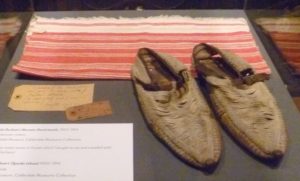
Edith Durham’s shoes made, traditionally, of leather and twine. They were soaked in oil until pliable and they moulded themselves on your feet into shape as they dried. The soles were good at gripping rocks. © Calderdale Museums Collection
But, in spite of women doing such complicated work to a highly professional standard, the female sex was viewed by the men as not quite human: women had no rights whatsoever. Take the story of the widow who fell in love with her brother-in-law and got pregnant. The men of her original family were furious and shot the brother-in-law. Edith asked, ‘If blame or punishment were given to the woman, which surprised everyone. They considered her a chattel, and in no way responsible.’ Fortunately, women weren’t shot in the blood feuds – perhaps they were just too useful.

Traditional Albanian costumes, sketched by Edith Durham in 1907. Note the bulk – Albania can be cold. © Calderdale Museums Collection
Albania, labouring under a cruelly repressive Turkish regime – which had promised much but delivered nothing – was still savagely taxed. The result was that the mountain tribesmen avoided all contact with the outside world, especially the Turks, wherever possible. Visitors from abroad were rare and the tribesmen were astonished by Edith Durham’s arrival on horseback, accompanied by only a horse boy and her trusted Albanian guide, Marko Shantoya, a stout man in his sixties. Women never travelled by themselves. Her explanation of being interested in their lives was impossible to believe. They decided that she must have been sent by the British king to find out their grievances – and to redress them.
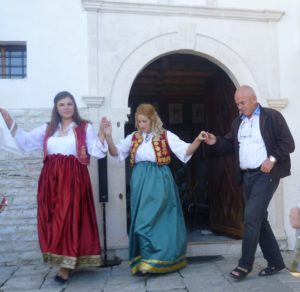
21st century girls in their version of Albanian tradition dress dancing with our Albanian guide, Ilia, Zekate House, Gjirokastra.
Born in London in 1863 into a well-to-do middle class family, the eldest of nine children (she had five sisters) Edith Durham was well educated and had trained as an artist at the Royal Academy Schools. After an illness in her late thirties, she found herself in the unenviable position of being considered the spinster daughter, the one who would stay at home and look after her mother. She wrote despairingly, ‘The future stretched before me in endless years of grey monotony, and escape seemed hopeless.’ Not unnaturally, she became depressed.
Fortunately, her sympathetic doctor prescribed two months holiday every year. ‘Get right away, no matter where, so long as the change is complete.’ He may have suspected that, if she just went to the seaside on the south coast, not far away, it would have been all too easy for her mother to summon her home.

Albania: looking up at the castle of Berat
Instead, in April 1900, she set sail from Trieste and explored the Dalmatian coast, Baedeker in hand – and fell in love with it. The moment she got back to London, she set about exploring Balkan history and teaching herself the Serbian language. From then on, every holiday saw her becoming more and more adventurous, as she set out to explore everyday life and customs in the Balkans.
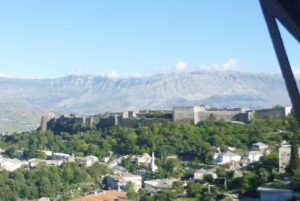
View towards the castle of Gjirokastra with mountains beyond
When I visited Albania myself a few years ago, I took Edith Durham’s book with me. The country was just emerging from 45 years of Enver Hoxha’s repressive Stalinist communism, made worse by his paranoia about the suspected intentions of the U.S.A. and the West (evil, naturally). The country had been run into the ground financially and things were difficult for the newly liberated, but almost bankrupt, Albania.
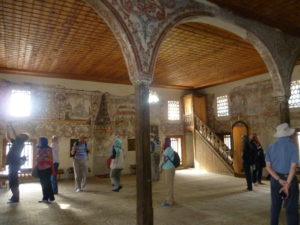
Inside an old mosque, now only visited by visitors interested in old frescos
Under Hoxha, Albania became atheist; mosques and churches were destroyed, or were neglected and fell into disuse. In the early 19th century, when Edith Durham was there, the two religions lived side by side without too much trouble and, as Edith put it, Albanians were Albanian first and then Moslem or Christian. (This still seems to be the case.)
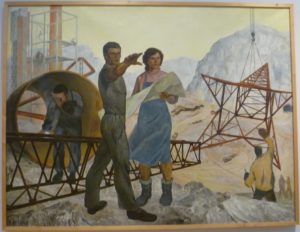
The Communist era: 1944-1992 Building a new world? The woman holding the architect’s plans is working alongside the man, although I doubt that her pay matches his. The National Gallery, Tirana.
Hoxha stamped out the blood feuds and liberated the women. At least, he gave women the vote, even if there was only one party they could vote for – his own.

Here the brave Albanians, under Enver Hoxha, are fighting the Nazis, and, by the looks of it, winning. He is their hero, according to the Communist national story. National Gallery, Tirana.
There is, however, another side to Edith Durham, and one I would never have expected. When I looked to see what the new exhibition at 2 Temple Place for 2020 would be, I discovered that it was ‘Unbound: Visionary Women Collecting Textiles.’ And, to my amazement, one of the women it featured was Edith Durham, the anthropologist, who, I now learnt, had also been a serious collector of Albanian folk costumes and she had left her costume collection to the Bankfield Museum, Halifax, and her photographs and sketches to the Royal Anthropological Institute, of which she was a council member and its first woman vice-president.
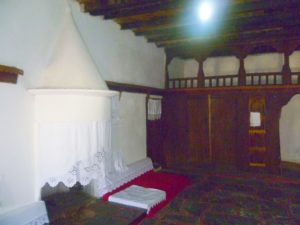
Zekate House, rich, mid-19th century merchant’s house in Gjirokastra: the women’s quarters, on the 1st floor, together with the kitchens. The main (male) quarters were upstairs.
I re-read High Albania, and, this time, I studied her sketches of the inside of homes, of the costumes people wore, the objects of interest she came across, and noted that, in between her hair-raising journeys up steep mountain paths, and her horrific accounts of the blood feuds, she also had much to say about everyday things which, somehow, I’d overlooked.

Man’s waistcoat, 1907. © Calderdale Museums Collection
And Edith has plenty to say about what people wore, for example, in her account of the Feast of the Translation of St Nicholas, to which she’d been invited and where she made notes about the men’s costumes: they were, of course, armed to the teeth and they wore, ‘snow-white head-wraps… Crimson and gold (bolero jackets) … and the splendidly decorative black braiding of the tight-fitting (trousers), and the heavy silver watch chain and pistol chains – set with the false rubies and turquoise loved of the mountain man.

Elaborate female dress, obviously ‘for best’. 1907 © Calderdale Museums Collection
‘The girls’ dress is of thick, stiff, white wool with horizontal black straps. The skirt and bodices are joined, and the bodice is open at the sides. Under the dress they wear a shirt with long sleeves and no other garment save the long stockings knitted in fancy patterns of red and black or black and white.
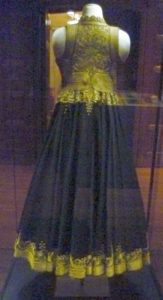
Elaborate female dress – what she wore underneath the example above. © Calderdale Museums Collection
‘Married women wear a black bell-shaped skirt of stiff, heavy wool, striped with dull crimson or purple. The bodice is open at the side, and a thick epaulette, heavily fringed, covers the shoulder. Over the skirt is a heavy striped apron. And round the waist is a great leathern belt five or six inches wide, studded thickly with small nails.’

Patterned head dress in traditional design and, underneath, women’s over-socks – which look very thick and warm. © Calderdale Museums Collection
Everything Edith has to say about costume speaks of her detailed research into the subject. She has obviously found out about the materials used, felt their weight and texture, watched the women sewing, asked questions, maybe even tried braiding herself. The garments and their construction are meticulously observed.
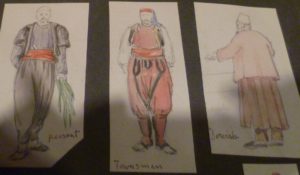
Men’s costumes: l – r. peasant, townsman, dervish. Elbasan, 1911 © Calderdale Museums Collection
The 2 Temple Place exhibition was an eye-opener for me. The curators – and I spoke to several of them – were passionate about the women collectors the exhibition featured; they felt strongly that this was an area which had been unfairly neglected as being of only female interest and, by definition, somehow less worthy of serious (that is, male) attention.
As their Press Release put it: ‘Unbound: Visionary Women Collecting Textiles celebrates seven pioneering women who saw beyond the purely functional, to reveal the extraordinary artistic, social and cultural importance of textiles …’
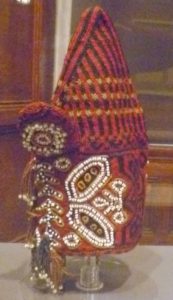
Elaborate old man’s gloves, noted as being very old-fashioned. 1907. In fact, it’s difficult to see how one might wear them with any comfort, which may explain why they have survived. © Calderdale Museums Collections
The exhibition demonstrates conclusively that textiles are crucial documents of social history as well as works of art in their own right, as the Edith Durham section proves abundantly. I loved it.

2 Temple Place
Unbound: Visionary Women Collecting Textiles is on at 2 Temple Place from 25th January to 19th April – and it’s free. Furthermore, the building itself, a late Victorian gem built for William Waldorf Astor, overlooking the Thames Embankment, is well worth a visit. Not to mention the café, which offers its visitors delicious tea, coffee and cakes.
Elizabeth Hawksley
Please share this page...
Once again, a fascinating blogpost. Is the braiding then sewn together to make the trousers? Or woven?
Thank you for your question, Jan. It’s just used for decoration, for example down the side seams for trousers, or round the edge for a jacket. The actual material for the garments was usually wool which was probably woven at home.
Aha, that makes much more sense. Thank you.
Great article! I came across Edith Durham’s travel writing when researching (in the Lit & Phil, Newcastle) the Scottish Women’s Hospitals in Serbia during the 1st WW – and the traumatic retreat to Albania in 1915. I’d love to see the exhibition, so thanks for flagging it up.
Thanks for dropping by, Janet. It must have been difficult for middle-class young women at a time when career opportunities were so limited, and social expectations so rigid, to get away from home and make something of your life. Considering she was supposed to be in poor health, Edith showed herself to be astonishingly tough in the mountains of Albania. And we hear no more of her depression.
You won’t be disappointed by the exhibition either, I’m sure.
I’ll have to make the trek down from the North before it ends!
Fascinating life. Absolutely begs for the historical novelist to write it up. How about it, Elizabeth?
I agree, Elizabeth. Tracy Chevalier’s new book ‘A Single Thread’ was inspired by the work one of the other women collectors in the exhibition, Louisa Pesel, who set up the post WWI tapestry work on kneelers, altar frontals etc. for Winchester Cathedral.
I hope to do a post on Louisa Pesel at some point. Very interesting woman.